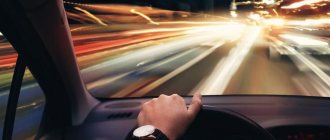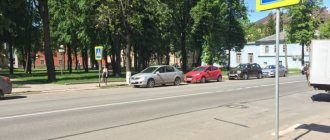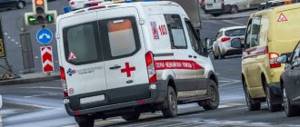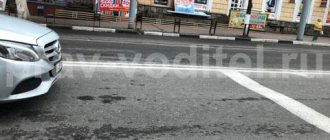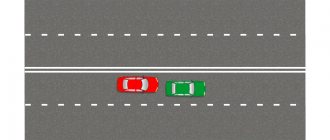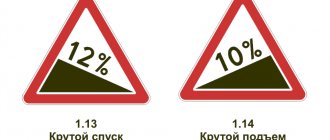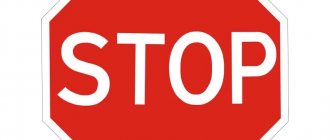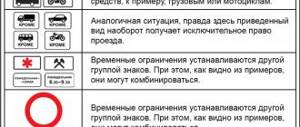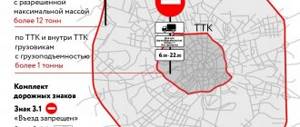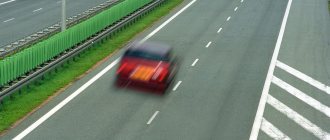The rules for driving on the highway are regulated by paragraph 16 of the traffic rules, which defines the basic standards of behavior for drivers on this type of road. What is a motorway? A motorway is a high-speed road for which the designation with the sign Motorway 5.1 is applicable.
Each direction of movement along the roadway is separated from the other by means of a dividing strip. Or, in the absence of the latter, a road fence. The motorway does not intersect at the same level with other roads, pedestrian or bicycle paths, tram or railway tracks.
The end of the motorway is indicated by sign 5.2. The question of correct movement on this type of road is included in the mandatory oral exam in driving schools.
Speed limit on motorway
Motorway sign 5.1.
According to paragraph 16.1 of the Rules, the minimum speed on the highway should not be lower than 40 km/h .
This excludes the use of the road by such traffic participants as: pets; pedestrians; mopeds; bicycles; self-propelled vehicles; tractors, etc.
This restriction applies regardless of the reason why it is impossible to reach a speed of more than 40 km/h - due to technical characteristics or condition. However, there are no categorical restrictions on the minimum speed on the highway in regulatory documents.
The maximum speed on a motorway depends on where the expressway is located:
- if the highway is located inside a populated area, the maximum permitted speed does not exceed 60 km/h.
- if the highway is located outside a populated area - the maximum speed is 110 km/h, which is prescribed by paragraph 10.3
It is worth noting that on some highways located outside populated areas, the permissible maximum speed can reach 130 km/h .
This change was made in 2013, and for highways of this type a corresponding sign 3.24 must be installed, which informs drivers of the speed limit. Driving with a trailer is only permissible at a speed of no more than 90 km/h .
For speeding, the driver will be fined or will have to lose his driving license. The amount of the fine will depend on how much the speed was exceeded. At the same time, a fine of 1,000 rubles will be imposed on the driver of a vehicle whose technical characteristics do not provide for a speed of 40 km/h or higher, provided that the vehicle is driven onto the highway . These restrictions are due to traffic safety requirements.
When driving at a speed of 110 km/h, it is very difficult to notice a slowly moving vehicle and navigate the situation. All this can cause an accident.
Fines for speeding on the highway
The amount of the administrative fine for exceeding the permitted speed varies depending on the severity of the violation.
That is, the faster you drive, the more severely the offender will be punished.
An administrative fine is imposed on the offender in accordance with Article 12.9 Part 2 of the Code of Administrative Offenses of the Russian Federation. This article for violating the rules established by traffic rules implies the following penalties:
- 500 rubles – for driving 20-40 km/h faster from the established upper limit;
- 1-1.5 thousand rubles – for driving 40-60 km/h faster than the permissible limit;
- 2-2.5 thousand rubles or deprivation of driving license for a period of 4 to 6 months, for exceeding 60-80 km/h;
- 5 thousand rubles and deprivation of rights for six months - for driving 80 km/h or more in excess of the norm.
Since fast-moving vehicles cannot be stopped urgently in an emergency situation, therefore, when accelerating, the driver must take into account not only traffic regulations and road signs, but also the technical characteristics of the vehicle, as well as the situation on a specific section of the road (visibility, congestion, quality of the road surface) and weather conditions.
Stop on the motorway
Stopping is permissible only in those places where there are special signs “resting place” and “parking place”.
If a forced stop is required on the highway, then in this case an emergency signal and the use of a warning triangle are required. Also, if possible, it is necessary to move the vehicle beyond the solid line limiting the road surface. It is better to place the emergency sign as far as possible to attract the attention of fast moving vehicles.
Maximum speed on Russian highways
The permissible speed limit depends on the category of vehicles. Clause 10 of the rules “Movement speed” provides the following information:
- Passenger cars, motorcycles and trucks weighing no more than 3.5 tons can accelerate to 110 km/h.
- Small and intercity buses should not exceed 90 km/h. The same applies to trucks whose weight exceeds 3.5 tons.
- If a truck carries passengers in the back, its maximum speed is 60 km/h. Buses carrying organized groups of children must adhere to the same speed limit.
On certain sections of highways, it is allowed to exceed the speed limit for certain types of transport. We are talking about cars, motorcycles and light trucks that can travel at speeds of up to 130 km/h. The increase in top speed is due to improved road surfaces. In such areas, a sign 3.24 is installed, on which the number “130” is depicted.
Location of vehicles
As stated in paragraph 9.4 of the Rules, drivers should stick to the right edge of the road when driving on the highway. This requirement is valid regardless of the location of this type of roadway - in a populated area or outside it.
Knowledge of the basic principles by which traffic on the highway is carried out will reduce the likelihood of an accident associated with non-compliance with the speed limit on the specified type of roadway.
Video: Highway driving rules
Minimum speed on motorways
Traffic regulations do not limit the minimum speed on Russian roads. The exception is motorways, where you must drive at a speed of more than 40 km/h. A car traveling at a slower speed creates an obstacle for other cars.
If a car cannot reach the established speed minimum due to a breakdown, then its driver must take the following actions:
- Move the car beyond the solid line, stopping on the side of the road on the right.
- Call a tow truck.
When driving on motorways at speeds less than 40 km/h, the driver may be fined.
Driving school online
That is, it turns out that only cars and motorcycles are allowed to travel on the highway. And even then not for everyone, but only for those who can move at a speed of at least 40 km/h. These notorious 40 km/h, by the way, need to be understood correctly. Driving at low speeds is not prohibited as such. Well, imagine that there is a traffic jam for many kilometers on the highway. Everyone is crawling at a snail's pace, and what about all the rule breakers? Of course not
It’s another matter if a breakdown is discovered in the car, with which you can move, but only carefully and slowly
There are no paths for cyclists or pedestrians.
Vehicles can only travel on the highway at high speeds. The carriageways of such a road are separated by a special barrier. Thus, the entire road is divided into two parts, which lead in opposite directions. All two lanes have two more lanes, which can be used to determine the place of overtaking, braking, etc.
— at the beginning of the highway; — with a sign 8.1.1 in front of the turnaround point or intersection closest to the beginning of the highway; - with a sign 8.1.3 or 8.1.4 before exits to the motorway at intersections at different levels, before the intersection closest to the motorway with the road that goes further into the motorway; — with sign 8.3.1 before exiting the highway at the junction at the same level; - with signs 8.3.1, 8.3.2 before entering the highway starting at an intersection at the same level (Figure B.5). Repeated 5.1 signs may be installed after entering the highway.
According to the Rules of the Road: “Highway” is a road marked with sign 5.1 and having carriageways for each direction of travel, separated from each other by a dividing strip (and in its absence, by a road fence), without intersections at the same level with other roads, railways or tram tracks, pedestrian or bicycle paths. Motorway speed: Outside populated areas, the following are permitted: - cars and trucks with a permissible maximum weight of no more than 3.5 tons on highways - at a speed of no more than 110 km/h, on other roads - no more than 90 km/h; - intercity and small buses and motorcycles on all roads - no more than 90 km/h; - other buses, cars when towing a trailer, trucks with a permissible maximum weight of more than 3.5 tons on highways - no more than 90 km/h, on other roads - no more than 70 km/h; - trucks carrying people in the back - no more than 60 km/h; — vehicles carrying out organized transportation of groups of children — no more than 60 km/h; — vehicles towing motor vehicles are allowed to travel at a speed of no more than 50 km/h.
Stopping and parking (intentionally stopping traffic) on highways is allowed only in special areas marked with signs 6.4 or 7.11.
In the event of a forced stop, if the vehicle is unable to reach under its own power the lane marking the edge of the roadway, separated by markings 1.2.1
the term "motorway" means a road specially constructed and intended for the traffic of motor vehicles, which does not serve roadside properties and which, i) except in certain places or on a temporary basis, has separate carriageways for both directions of traffic, separated from each other by a median strip not intended for movement, or, in exceptional cases, by other means; ii) does not intersect at the same level with roads, railway or tram tracks, or pedestrian paths; iii) specially designated as a highway; Road signs indicating the beginning and end of a highway, respectively: A highway is distinguished from an ordinary road by: The mandatory presence of a dividing strip; Absence of intersections and other intersections at the same level; Maximum permitted speed from 110 to 130 km/h; There are no sidewalks on the highway and pedestrian traffic is prohibited; Driving of livestock is prohibited; Bicycles and mopeds are prohibited; The movement of tractors and self-propelled machines and other vehicles whose speed does not exceed 40 km/h is prohibited; U-turn is prohibited; Reversing is prohibited; Training driving is prohibited. The highway belongs to category IA roads.
Rules for driving on expressways
- In accordance with paragraph 16.1 of the traffic rules, the movement of vehicles weighing more than 3.5 tons beyond the second lane is prohibited here. Slow-moving trucks, vans and vans slow down passenger cars, which is why they should give them an advantage in reaching the permitted speed.
- Question answer
What amendments will be made to the traffic rules? Previously, driving lessons with an instructor were prohibited on highways. This restriction has now been lifted. From January 1, 2021, amendments to the rules came into effect, and training vehicles with an instructor can be driven on highways.
- Stopping on the highway is strictly prohibited everywhere, even on the side of the road. You can stop only in specially designated places marked with signs 7.11 “Rest place” and 6.4 “Parking place”. You can also relax at gas stations, which often have cafes.
- In accordance with Part 1 of Article 12.11 of the Code of Administrative Offenses of the Russian Federation, driving a vehicle on a highway at a speed of less than 40 km/h, as well as stopping a vehicle on a highway outside special parking areas, entails an administrative fine of 1,000 rubles.
- Reversing is also prohibited on expressways. If the driver has passed his turn at an interchange, then it is not allowed to stand on the emergency light on the side of the road and turn back a few tens of meters. You must drive forward to the next junction and return only along the opposite overpass.
- It is allowed to turn around only at special road junctions. You cannot cross the dividing strips, even when there is a technological gap in the fences.
- In accordance with Part 3 of Article 12.11 of the Code of Administrative Offenses of the Russian Federation, “turning or driving a vehicle into technological gaps in the dividing strip on a highway or driving in reverse on a highway entails an administrative fine in the amount of two thousand five hundred rubles.”
What is a car's cruising speed? More details
It is important to remember one of the main unspoken rules. When driving at high speed, you need to keep the vehicle as close to the right side of the roadway as possible. This gives the overtaking vehicle more room to maneuver. In this case, even on one lane there will be enough space to avoid a collision with a passing car.
